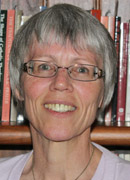
A deacon candidate mentioned that whenever The Catholic Messenger publishes a story and photos of deacon candidates, people congratulate him because they assume he’s just been ordained!
People glance at the photos, see men in white (albs) kneeling before a bishop, and assume that a priest or deacon is being ordained.
The deacon candidate shared that story in his Sacraments of Vocation class last weekend to illustrate the point that some Catholics and non-Catholics are confused about what’s entailed in becoming a deacon.
Members of my own family get confused when they see a deacon wearing a dalmatic, which resembles the priest’s chasuble, except the dalmatic has sleeves and other distinguishing characteristics that might not be readily apparent to people in the pews.
Clarity about the difference between vestments can contribute to an understanding about one “external” aspect of holy orders. But what’s more important is clearing up confusion about the nature of diaconal ministry.
Twelve candidates in Deacon Class VI, God willing, will be ordained to the permanent diaconate in spring 2013 having completed a six-year formation process. Some of them say they’ve heard people refer to deacons as junior priests. Other people have asked whether deacons get paid for their ministry; others are surprised to learn that married men are deacons; still others see the deacon as a go-between to the priest, the candidates said.
As a lay member of their class, I am being exposed to the theology of the diaconate. The lived experiences of long-ordained deacons and the candidates and their wives are very much a part of that theology and education. The insight I am gaining ought to be available to every Catholic in our diocese.
In last week’s class, we explored the sacrament of marriage and the sacrament of holy orders, so-called sacraments of vocations. Only a married deacon is a recipient of both, which creates unique opportunities and challenges in their ministries of service, observed our instructor, Professor Corinne Winter of St. Ambrose University in Davenport.
If we were to describe a theology of vocation, she asked our class, what would we include? A particular call to service, Christ’s relationship to the Church, the universal call to holiness, relationship and communion would be among the components, we said.
“Every particular vocation is a way of living out that universal vocation that all of us have by virtue of our baptism,” Professor Winter noted.
The Catechism of the Catholic Church teaches that the sacraments of “Holy Orders and Matrimony are directed toward the salvation of others … They confer a particular mission in the Church and serve to build up the People of God” (CCC, 1534).
Deacons, “strengthened by sacramental grace, are dedicated to the People of God, in conjunction with the bishop and his body of priests, in the service (diakonia) of the liturgy, of the Gospel and of the works of charity,” the Catechism states. (1588)
Professor Winter observed that deacons and their wives strive to model Christ, the servant, in the humility and the ordinariness of his service to others.
Ordination requires deacons and their wives to live and cultivate the renewing grace of their marital sacrament in community through a ministry of service, charity and justice, said the Rev. Mark Latcovich in an essay in “The Deacon Reader” (p. 230).
Whatever confusion exists about the diaconate poses an opportunity and an obligation for Catholics to deepen their sacramental understanding of the Church, Professor Winter suggested. “Sacraments place us in the context of the whole history of salvation and cement our relationship with God.”
Barb Arland-Fye







